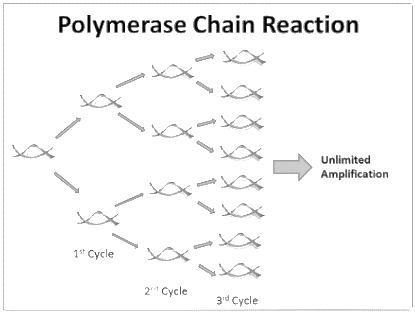
The process of polymerase chain reaction most closely mirrors to that of

A. Replication
B. Transcription
C. Translation
D. Meiosis

Answer
465k+ views
Hint: This technique allowed DNA sequences to be amplified in vitro using pure enzymes. The great sensitivity and robustness of the PCR allow DNA to be prepared rapidly from very small amounts of starting material.
Complete step by step answer: The first step of the PCR is an initialization, where the thermocycler is heated so that the DNA polymerases are activated. The next step is denaturation, where the two strands of DNA template are denatured by breaking the hydrogen bonds at around 94°C- 98°C. Now, in the annealing step, the forward and reverse primers are attached to the complementary templates at around 50°C -65°C. In the next step, the extension of the new template takes place. From the 5’ to 3’, Taq polymerases allow the synthesis of the new strand complementary to the template strand with the help of primers at 75–80 °C. The PCR occurs in vitro in a thermocycler.
i. Replication is the synthesis of new DNA strand from its complementary template strand in vivo using the replication machinery including helicase, primers, DNA polymerase. It involves steps like initiation, elongation and termination. The DNA synthesis has directionality and can the replication fork can form a leading strand and a lagging strand.
ii. The transcription is a process in which the mRNA is formed from the template DNA strand using the transcriptional machinery in vivo. There is no amplification of the DNA template. Functional mRNA is formed instead.
iii. Translation is the process where a protein chain is formed from the mRNA using the translational machinery using ribosomes and the open reading frame of mRNA along with other enhancers and activators.
iv. Meiosis is the formation of four cells from a single cell. It occurs in germ cells where the genes are inherited from both father and mother.
Hence, the correct answer is option A.
Note: The PCR method was first proposed by H. Khorana and his colleagues in the early 1970s to lessen the labour involved with the chemical synthesis of genes. However, it was not accepted during that time. After 15 years the technique was independently developed by Kary Mullis and his co-workers and given its present name Polymerase Chain Reaction.
Complete step by step answer: The first step of the PCR is an initialization, where the thermocycler is heated so that the DNA polymerases are activated. The next step is denaturation, where the two strands of DNA template are denatured by breaking the hydrogen bonds at around 94°C- 98°C. Now, in the annealing step, the forward and reverse primers are attached to the complementary templates at around 50°C -65°C. In the next step, the extension of the new template takes place. From the 5’ to 3’, Taq polymerases allow the synthesis of the new strand complementary to the template strand with the help of primers at 75–80 °C. The PCR occurs in vitro in a thermocycler.
i. Replication is the synthesis of new DNA strand from its complementary template strand in vivo using the replication machinery including helicase, primers, DNA polymerase. It involves steps like initiation, elongation and termination. The DNA synthesis has directionality and can the replication fork can form a leading strand and a lagging strand.
ii. The transcription is a process in which the mRNA is formed from the template DNA strand using the transcriptional machinery in vivo. There is no amplification of the DNA template. Functional mRNA is formed instead.
iii. Translation is the process where a protein chain is formed from the mRNA using the translational machinery using ribosomes and the open reading frame of mRNA along with other enhancers and activators.
iv. Meiosis is the formation of four cells from a single cell. It occurs in germ cells where the genes are inherited from both father and mother.
Hence, the correct answer is option A.
Note: The PCR method was first proposed by H. Khorana and his colleagues in the early 1970s to lessen the labour involved with the chemical synthesis of genes. However, it was not accepted during that time. After 15 years the technique was independently developed by Kary Mullis and his co-workers and given its present name Polymerase Chain Reaction.
Recently Updated Pages
Master Class 11 Accountancy: Engaging Questions & Answers for Success

Glucose when reduced with HI and red Phosphorus gives class 11 chemistry CBSE

The highest possible oxidation states of Uranium and class 11 chemistry CBSE

Find the value of x if the mode of the following data class 11 maths CBSE

Which of the following can be used in the Friedel Crafts class 11 chemistry CBSE

A sphere of mass 40 kg is attracted by a second sphere class 11 physics CBSE

Trending doubts
Define least count of vernier callipers How do you class 11 physics CBSE

The combining capacity of an element is known as i class 11 chemistry CBSE

Proton was discovered by A Thomson B Rutherford C Chadwick class 11 chemistry CBSE

Find the image of the point 38 about the line x+3y class 11 maths CBSE

Can anyone list 10 advantages and disadvantages of friction

Distinguish between Mitosis and Meiosis class 11 biology CBSE




